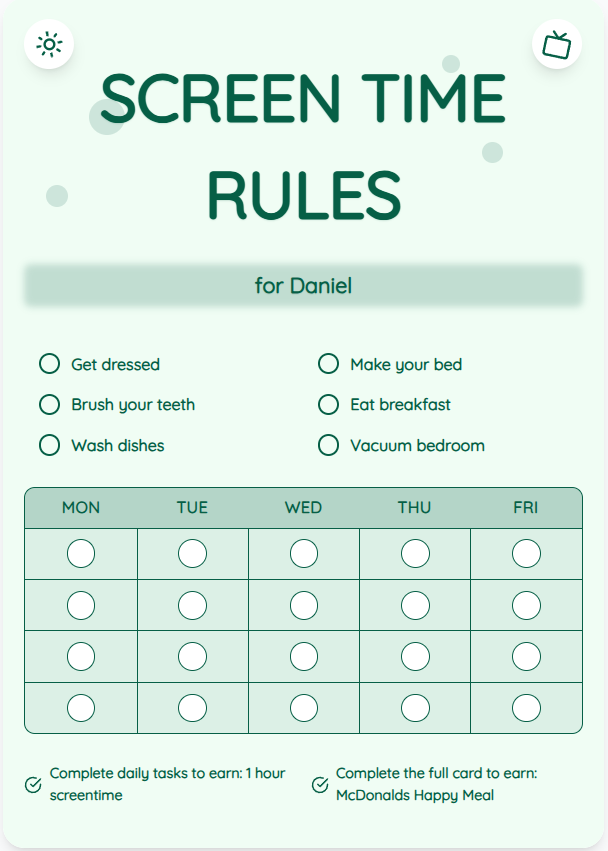Screen Time Today: Practical Strategies for Parents of Children Ages 2-12
In today's digital age, managing screen time for kids is a crucial aspect of parenting. As parents, finding the right balance between technology use and other activities is essential for our children's well-being and development. This guide provides actionable advice and tips to help you navigate the challenges of screen time management effectively.
See What Your Screen Time Chart Will Look Like
Here's an example of a beautiful, customizable screen time rules chart you can create for your family

Understanding Screen Time Guidelines
Setting clear screen time guidelines is the first step in managing your child's device usage. The American Academy of Pediatrics recommends limiting screen time to 1 hour per day for children aged 2-5 and ensuring that screen time does not interfere with sleep, physical activity, and other essential activities. By establishing boundaries early on, you can create a healthy tech environment for your child.
Creating a Screen Time Schedule
Developing a consistent screen time schedule helps regulate your child's tech usage. Consider using a screen time chart generator like ScreenTimeRules.com to create a visual schedule that allocates time for educational content, creative play, outdoor activities, and family time. By incorporating structured screen time intervals into your child's routine, you promote a balanced approach to technology.
Put These Tips Into Action
Create a custom chart to implement these strategies with your child
Encouraging Alternative Activities
Encouraging your child to engage in non-screen activities is vital for their holistic development. Provide opportunities for reading, arts and crafts, physical exercise, and social interactions to reduce reliance on screens. By introducing diverse activities into your child's daily routine, you foster creativity, social skills, and emotional well-being.
Practical Tips for Success
- Set clear screen time rules and communicate them effectively with your child.
- Use positive reinforcement to encourage adherence to screen time limits.
- Engage in tech-free activities as a family to model healthy screen habits.
- Monitor the content your child consumes online to ensure age-appropriate viewing.
Frequently Asked Questions
How can I handle resistance when implementing screen time limits?
It's common for children to resist new rules, including those related to screen time. Consistency is key. Stay firm yet empathetic, explain the reasons behind the limits, and offer alternative activities to make the transition smoother.
Is it okay to use screen time as a reward for good behavior?
While using screen time as a reward can be effective in the short term, it's important to avoid associating device use solely with positive behavior. Encourage intrinsic motivation by praising efforts and achievements instead of relying solely on external rewards.
How can I limit my own screen time as a parent role model?
As a parent, modeling healthy screen habits is crucial. Set boundaries for your own device use, designate tech-free times during family moments, and engage in activities that do not involve screens. By demonstrating balanced screen habits, you set a positive example for your child.
Managing screen time effectively requires a proactive approach that considers your child's developmental needs and overall well-being. By implementing consistent rules, creating a structured schedule, and promoting alternative activities, you can cultivate a healthy tech balance in your household. Explore the benefits of utilizing screen time charts as visual aids for your child's routine. Start implementing these strategies today for a harmonious family life.
Ready to Transform Your Family's Screen Time?
Join thousands of parents who have successfully managed screen time with our customizable charts.
